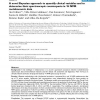251 search results - page 4 / 51 » Using self-dissimilarity to quantify complexity |
ACSAC
2010
IEEE
14 years 9 months ago
2010
IEEE
Leakage of confidential information represents a serious security risk. Despite a number of novel, theoretical advances, it has been unclear if and how quantitative approaches to ...
IROS
2007
IEEE
15 years 5 months ago
2007
IEEE
— Any system that has the capability to diagnose and recover from faults is considered to be a fault-tolerant system. Additionally, the quality of the incorporated fault-toleranc...
130
click to vote
PRDC
2009
IEEE
15 years 6 months ago
2009
IEEE
—With ever-growing complexity of computer and communication systems analytical methods do not scale, especially with respect to dependability assessment of information technology...
103
click to vote
BMCBI
2007
14 years 11 months ago
2007
Background: A key challenge in metabonomics is to uncover quantitative associations between multidimensional spectroscopic data and biochemical measures used for disease risk asse...
132
click to vote
DLT
2009
14 years 9 months ago
2009
Abstract. Temporal logics are a well investigated formalism for the specification and verification of reactive systems. Using formal verification techniques, we can ensure the corr...

